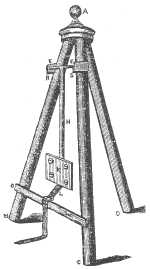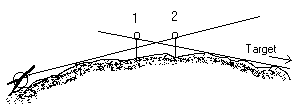The Gun - Smoothbore Era 1550-1860: Ballistics and GunneryAt the beginning of the smooth-bore era Gunners knew little of the motion of projectiles, with which the science of ballistics is concerned. For example, they believed a shot fired from a gun travelled in a straight line to some point in space, then fell vertically to earth! Important as a pioneer attempt to establish laws of moving bodies was the publication of Nova Scientia by an Italian mathematician, Niccolo Fontana (1499 - 1559). During the sack of Brescia by the French in 1512 he suffered a sabre cut to the head which left him with an impediment in his speech - plus the nickname 'Tartaglia' (stutterer) which he later adopted as his surname and by which he is generally known. Other works in 1546 and 1551 represent the first recorded scientific approach to the theory as distinguished from the prevailing rules of thumb. Although in some measure incorrect, his ideas on the trajectory of a roundshot were so far ahead of his day that he justly deserves the title of the first ballistician. Tartaglia was the first to point out that the trajectory was not flat but curved, and that the higher the muzzle velocity the flatter the trajectory. He was also first to prove that the maximum range of a gun is achieved at an elevation of 45°, a statement which remained true until the appearance of 20th century ordnance capable of putting projectiles into the stratosphere. But he did draw erroneous conclusions; for example, he claimed that if the maximum range of a gun was 2000 yards, and the point blank range was 200, ie the range achieved with the piece level, then equal portions of 45° would achieve equal increments of the remaining 1800, a theory which did not take into account air resistance and gravity. Tartaglia was honest enough to admit his theories did not always work out in practice. | |
|
Most other authors on the subject during the 16th and 17th centuries based their writings on Tartaglia, although some did dispute certain of his theories. In 1742 Benjamin Robins (1707-51) invented his ballistic pendulum, an instrument designed to measure the velocity of a projectile directed at it.Knowing the weight of the pendulum,H, with target, K, the weight of the shot fired, and the distance the pendulum moved when struck (measured by strap L), it was possible to calculate the velocity of the shot. By performing experiments at various distances Robins was able to determine the loss of velocity as range increased, and therefore the effects of air density and gravity. The instrument had its faults, but at least its design was based upon logical thought, not on rules of thumb or guesswork. Robins published his findings in New Principles of Gunnery 1742. Had more notice been taken of them at the time the technical development of ordnance might have progressed much faster. |
 Ballistic Pendulum |
Gunnery of the Smoothbore Era
Aiming posts 1 and 2 had to be in line with the target and also in line gun-target. | |
ParallelismBecause neither director nor dial sight was available, making lines of fire parallel was possible only by rough and ready methods. For example, in the figure here the drill was: |
 
|
The remaining guns in the battery were made parallel in the same way.
Concentration and distributionThis exercise could be carried out by guns with open sights fitted with deflection scales - to a limited extent. Needless to say the exercises outlined above were not repeated often. RangingIn a drill laid down in 1757 the Number One, who laid his gun and corrected its fire, ensured the first round fell short. He then increased elevation until he obtained a hit. Such shooting is frowned upon today, but during the smooth-bore era once the target had been indicated by the BC the Number One was on his own. There was no OP, so if the first rounds were plus the chances were they would be unobserved, and therefore wasted. | |
RangefindingThroughout the smooth-bore era great emphasis was placed on the ability of Gunners to judge distances, and they were frequently exercised in this skill at ranges up to 2000 yards (1829 metres). In field artillery the No 1 estimated the range to his target by experience. This was not as difficult as might be supposed, as field guns rarely opened fire at ranges over 1000 yards (914 m), their maximum effective range. Not only did the striking power of roundshot fall off rapidly over this range, but the layer had difficulty in distinguishing the target. Telescopes were not fitted to guns prior to the last two decades of the 19th century, and then only to coast artillery equipments. No serious attempts to obtain ranges by instrumental methods were made before 1770. That year saw the short base method put to limited use, eg for siege purposes, but it was a time-consuming process. Development of efficient optical rangefinders did not commence until 1860, at the start of the rifled era, and culminated in the introduction of the well-known Barr & Stroud types 20 years later. |
 Measuring angles G and B |
|
WL Ruffell, 1996 previous | index | next | History index | Home | |
 During the smooth-bore era virtually all fire was direct. On the very rare occasions indirect fire was attempted it invariably involved siege operations in which ample time was available. Until the introduction of the dial sight in the last decade of the 19th century, indirect fire was not practicable; it involved a time-consuming lining up of aiming posts, was possible only in easy rolling country, and was generally suited to howitzers only.
During the smooth-bore era virtually all fire was direct. On the very rare occasions indirect fire was attempted it invariably involved siege operations in which ample time was available. Until the introduction of the dial sight in the last decade of the 19th century, indirect fire was not practicable; it involved a time-consuming lining up of aiming posts, was possible only in easy rolling country, and was generally suited to howitzers only.
 An early 18th century method of obtaining range by rough survey: An officer laid out a sub-base of 25, 50 or 100 yards to form a right-angled triangle, if possible, or if not an isosceles triangle. T=target, G=gun, GB=sub-base. He then measured angles G and B by plane table and sight rule. With these data he was thus able to deduce the angle T and calculate GT.
An early 18th century method of obtaining range by rough survey: An officer laid out a sub-base of 25, 50 or 100 yards to form a right-angled triangle, if possible, or if not an isosceles triangle. T=target, G=gun, GB=sub-base. He then measured angles G and B by plane table and sight rule. With these data he was thus able to deduce the angle T and calculate GT.